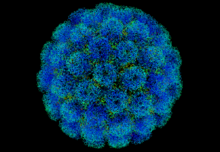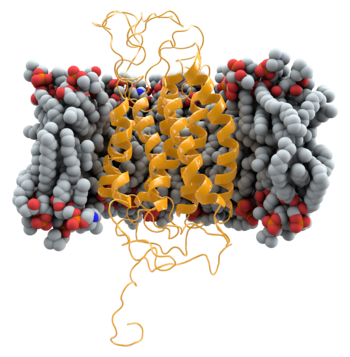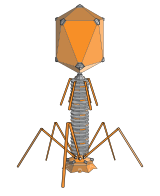Our website is made possible by displaying online advertisements to our visitors.
Please consider supporting us by disabling your ad blocker.
Portal:Viruses
The Viruses Portal
Welcome!

Viruses are small infectious agents that can replicate only inside the living cells of an organism. Viruses infect all forms of life, including animals, plants, fungi, bacteria and archaea. They are found in almost every ecosystem on Earth and are the most abundant type of biological entity, with millions of different types, although only about 6,000 viruses have been described in detail. Some viruses cause disease in humans, and others are responsible for economically important diseases of livestock and crops.
Virus particles (known as virions) consist of genetic material, which can be either DNA or RNA, wrapped in a protein coat called the capsid; some viruses also have an outer lipid envelope. The capsid can take simple helical or icosahedral forms, or more complex structures. The average virus is about 1/100 the size of the average bacterium, and most are too small to be seen directly with an optical microscope.
The origins of viruses are unclear: some may have evolved from plasmids, others from bacteria. Viruses are sometimes considered to be a life form, because they carry genetic material, reproduce and evolve through natural selection. However they lack key characteristics (such as cell structure) that are generally considered necessary to count as life. Because they possess some but not all such qualities, viruses have been described as "organisms at the edge of life".
Selected disease
Variant Creutzfeldt–Jakob disease, or vCJD, is a rare type of central nervous system disease within the transmissible spongiform encephalopathy family, caused by a prion. First identified in 1996, vCJD is now distinguished from classic CJD. The incubation period is believed to be years, possibly over 50 years. Prion protein can be detected in appendix and lymphoid tissue (pictured) up to two years before the onset of neurological symptoms, which include psychiatric problems, behavioural changes and painful sensations. Abnormal prion proteins build up as amyloid deposits in the brain, which acquires a characteristic spongiform appearance, with many round vacuoles in the cerebellum and cerebrum. The average life expectancy after symptoms start is 13 months.
About 170 cases have been recorded in the UK, and 50 cases in the rest of the world. The estimated prevalence in the UK is about 1 in 2000, higher than the reported cases. Transmission is believed to be mainly from consuming beef contaminated with the bovine spongiform encephalopathy prion, but may potentially also occur via blood products or contaminated surgical equipment. Infection is also believed to require a specific genetic susceptibility in the PRNP-encoding gene. Human PRNP protein can have either methionine or valine at position 129; nearly all of those affected had two copies of the methionine-containing form, found in 40% of Caucasians.
Selected image
CCR5 is a human membrane protein that acts as a secondary receptor for HIV, enabling the viral and cell membranes to fuse. People with two copies of a mutated Δ32 form of CCR5 are naturally resistant to infection by most strains of HIV, and the normal form is the target of entry inhibitors such as maraviroc.
Credit: Thomas Splettstoesser (18 July 2012)
In the news
26 February: In the ongoing pandemic of severe acute respiratory syndrome coronavirus 2 (SARS-CoV-2), more than 110 million confirmed cases, including 2.5 million deaths, have been documented globally since the outbreak began in December 2019. WHO
18 February: Seven asymptomatic cases of avian influenza A subtype H5N8, the first documented H5N8 cases in humans, are reported in Astrakhan Oblast, Russia, after more than 100,0000 hens died on a poultry farm in December. WHO
14 February: Seven cases of Ebola virus disease are reported in Gouécké, south-east Guinea. WHO
7 February: A case of Ebola virus disease is detected in North Kivu Province of the Democratic Republic of the Congo. WHO
4 February: An outbreak of Rift Valley fever is ongoing in Kenya, with 32 human cases, including 11 deaths, since the outbreak started in November. WHO
21 November: The US Food and Drug Administration (FDA) gives emergency-use authorisation to casirivimab/imdevimab, a combination monoclonal antibody (mAb) therapy for non-hospitalised people twelve years and over with mild-to-moderate COVID-19, after granting emergency-use authorisation to the single mAb bamlanivimab earlier in the month. FDA 1, 2
18 November: The outbreak of Ebola virus disease in Équateur Province, Democratic Republic of the Congo, which started in June, has been declared over; a total of 130 cases were recorded, with 55 deaths. UN
Selected article
Bacteriophages (or phages) are a large and diverse group of viruses that infect bacteria and archaea. Their genome, which they inject into the host's cytoplasm, can be DNA or RNA, single or double stranded, linear or circular, and contains between four and several hundred genes. Their capsid can be relatively simple or elaborate in structure, and in a few groups is surrounded by an envelope. Caudovirales, double-stranded DNA phages with tails, is the best-studied group, and includes T4 (pictured), λ phage and Mu phage.
Among the most common entities in the biosphere, bacteriophages are ubiquitous in locations populated by bacteria. One of the densest natural sources is sea water, where up to 900 million virions/mL have been found in microbial mats at the surface, and up to 70% of marine bacteria can be infected.
Used as an alternative to antibiotics for over 90 years, phages might offer a potential therapy against multi-drug-resistant bacteria.
Selected outbreak
The West African Ebola epidemic was the most widespread outbreak of the disease to date. Beginning in Meliandou in southern Guinea in December 2013, it spread to adjacent Liberia and Sierra Leone, affecting the cities of Conakry and Monrovia, with minor outbreaks in Mali and Nigeria. Cases reached a peak in October 2014 and the epidemic was under control by late 2015, although occasional cases continued to occur into April 2016. Ring vaccination with the then-experimental vaccine rVSV-ZEBOV was trialled in Guinea.
More than 28,000 suspected cases were reported with more than 11,000 deaths; the case fatality rate was around 40% overall and around 58% in hospitalised patients. Early in the epidemic nearly 10% of the dead were healthcare workers. The outbreak left about 17,000 survivors, many of whom reported long-lasting post-recovery symptoms. Extreme poverty, dysfunctional healthcare systems, distrust of government after years of armed conflict, local burial customs of washing the body, the unprecedented spread of Ebola to densely populated cities, and the delay in response of several months all contributed to the failure to control the epidemic.
Selected quotation
| “ | An inefficient virus kills its host. A clever virus stays with it. | ” |
Recommended articles
Viruses & Subviral agents: bat virome • elephant endotheliotropic herpesvirus • HIV • introduction to viruses![]() • Playa de Oro virus • poliovirus • prion • rotavirus
• Playa de Oro virus • poliovirus • prion • rotavirus![]() • virus
• virus![]()
Diseases: colony collapse disorder • common cold • croup • dengue fever![]() • gastroenteritis • Guillain–Barré syndrome • hepatitis B • hepatitis C • hepatitis E • herpes simplex • HIV/AIDS • influenza
• gastroenteritis • Guillain–Barré syndrome • hepatitis B • hepatitis C • hepatitis E • herpes simplex • HIV/AIDS • influenza![]() • meningitis
• meningitis![]() • myxomatosis • polio
• myxomatosis • polio![]() • pneumonia • shingles • smallpox
• pneumonia • shingles • smallpox
Epidemiology & Interventions: 2007 Bernard Matthews H5N1 outbreak • Coalition for Epidemic Preparedness Innovations • Disease X • 2009 flu pandemic • HIV/AIDS in Malawi • polio vaccine • Spanish flu • West African Ebola virus epidemic
Virus–Host interactions: antibody • host • immune system![]() • parasitism • RNA interference
• parasitism • RNA interference![]()
Methodology: metagenomics
Social & Media: And the Band Played On • Contagion • "Flu Season" • Frank's Cock![]() • Race Against Time: Searching for Hope in AIDS-Ravaged Africa
• Race Against Time: Searching for Hope in AIDS-Ravaged Africa![]() • social history of viruses
• social history of viruses![]() • "Steve Burdick" • "The Time Is Now" • "What Lies Below"
• "Steve Burdick" • "The Time Is Now" • "What Lies Below"
People: Brownie Mary • Macfarlane Burnet![]() • Bobbi Campbell • Aniru Conteh • people with hepatitis C
• Bobbi Campbell • Aniru Conteh • people with hepatitis C![]() • HIV-positive people
• HIV-positive people![]() • Bette Korber • Henrietta Lacks • Linda Laubenstein • Barbara McClintock
• Bette Korber • Henrietta Lacks • Linda Laubenstein • Barbara McClintock![]() • poliomyelitis survivors
• poliomyelitis survivors![]() • Joseph Sonnabend • Eli Todd • Ryan White
• Joseph Sonnabend • Eli Todd • Ryan White![]()
Selected virus
Henipaviruses are a genus of RNA viruses in the Paramyxoviridae family. The variably shaped, 40–600 nm diameter, enveloped capsid contains a single-stranded, negative-sense RNA genome of 18.2 kb, with six genes. The cellular receptor is in the ephrin family. The natural hosts are predominantly bats, mainly the Pteropus genus of megabats (flying foxes) and some microbats. Bats infected with Hendra virus develop viraemia and shed virus in urine, faeces and saliva for around a week, but show no signs of disease. Henipaviruses can also infect humans and livestock, causing severe disease with high mortality, making the group a zoonootic disease. Transmission to humans sometimes occurs via an intermediate domestic animal host.
The first henipavirus, Hendra virus, was discovered in 1994 as the cause of an outbreak in horses in Brisbane, Australia. Nipah virus was identified a few years later in Malaysia as the cause of an outbreak in pigs. Three further species have since been recognised: Cedar and Kumasi viruses in bats, and Mòjiāng virus in rodents. Their emergence as human pathogens has been linked to increased contact between bats and humans. Human disease has been confined to Australia and Asia, but members of the genus have also been found in African bats. A veterinary vaccine against Hendra virus is available but no human vaccine has been licensed.
Did you know?
- ...that the stripes on tulips (examples pictured) that caused tulip mania were probably caused by a virus, but this was unknown to science at the time?
- ...that epidemiologist Li Lanjuan was the first to propose a lockdown of Wuhan during the 2019–20 coronavirus outbreak?
- ...that the human bocavirus is the fourth most commonly found virus in samples collected from the respiratory system?
- ...that research by Harold Ginsberg on adenoviruses led to the development of gene therapy, in which modified versions of viruses can be used to implant healthy versions of genes to treat disease?
- ...that the Tiverton fire of 1731 resulted in an increased incidence of smallpox?
Selected biography
Ryan Wayne White (6 December 1971 – 8 April 1990) was an HIV-positive American teenager who became a national spokesman for AIDS research and public education about HIV/AIDS, after being expelled from school because of his infection.
White, a haemophiliac, was diagnosed in 1984 after infection by a contaminated blood treatment. HIV/AIDS was then poorly understood, and his return to school in Kokomo, Indiana was prevented by protesters; the ensuing legal battle gained national media coverage. Before his case, AIDS was widely associated with the male gay community; White was one of several who helped to shift that perception.
White died in 1990, one month before his high school graduation. Shortly afterwards, the U.S. Congress passed a major piece of AIDS legislation, the Ryan White Care Act. Ryan White Programs remain the largest provider of services for people living with HIV/AIDS in the United States.
In this month
February 1939: First virology journal, Archiv für die gesamte Virusforschung, appeared
8 February 1951: Establishment of the HeLa cell line from a cervical carcinoma biopsy, the first immortal human cell line
12 February 1892: Dmitri Ivanovsky (pictured) demonstrated transmission of tobacco mosaic disease by extracts filtered through Chamberland filters; sometimes considered the beginning of virology
19 February 1966: Prion disease kuru shown to be transmissible
23 February 2018: Baloxavir marboxil, the first anti-influenza agent to target the cap-dependent endonuclease activity of the viral polymerase, approved in Japan
27 February 2005: H1N1 influenza strain resistant to oseltamivir reported in a human patient
24 February 1977: Phi X 174 sequenced by Fred Sanger and coworkers, the first virus and the first DNA genome to be sequenced
28 February 1998: Publication of Andrew Wakefield's Lancet paper, subsequently discredited, linking the MMR vaccine with autism, which started the MMR vaccine controversy
Selected intervention
Zidovudine (ZDV) (also known as AZT and sold as Retrovir) is an antiretroviral drug used in the prevention and treatment of HIV/AIDS. Classed as a nucleoside analogue reverse-transcriptase inhibitor, it inhibits HIV's reverse transcriptase enzyme, which copies the viral RNA into DNA and is essential for its replication. The first breakthrough in AIDS therapy, ZDV was licensed in 1987. While it significantly reduces HIV replication, leading to some clinical and immunological benefits, when used alone ZDV does not completely stop replication, allowing the virus to become resistant to it. The drug is therefore used together with other anti-HIV drugs in combination therapy called highly active antiretroviral therapy. To simplify its administration, ZDV is included in combination pills with lamivudine (Combivir) and lamivudine plus abacavir (Trizivir). ZDV continues to be used to prevent HIV transmission from mother to child during childbirth; it was previously part of the standard post-exposure prophylaxis after needlestick injury.
Subcategories
Subcategories of virology:
Topics
Things to do
- Comment on what you like and dislike about this portal
- Join the Viruses WikiProject
- Tag articles on viruses and virology with the project banner by adding {{WikiProject Viruses}} to the talk page
- Assess unassessed articles against the project standards
- Create requested pages: red-linked viruses | red-linked virus genera
- Expand a virus stub into a full article, adding images, citations, references and taxoboxes, following the project guidelines
- Create a new article (or expand an old one 5-fold) and nominate it for the main page Did You Know? section
- Improve a B-class article and nominate it for Good Article
 or Featured Article
or Featured Article status
status - Suggest articles, pictures, interesting facts, events and news to be featured here on the portal
WikiProjects & Portals
 WikiProject Viruses
Related WikiProjects
WikiProject Viruses
Related WikiProjects
Medicine • Microbiology • Molecular & Cellular Biology • Veterinary Medicine
Related PortalsAssociated Wikimedia
The following Wikimedia Foundation sister projects provide more on this subject:
-
Commons
Free media repository -
Wikibooks
Free textbooks and manuals -
Wikidata
Free knowledge base -
Wikinews
Free-content news -
Wikiquote
Collection of quotations -
Wikisource
Free-content library -
Wikispecies
Directory of species -
Wikiversity
Free learning tools -
Wiktionary
Dictionary and thesaurus
Previous Page Next Page





















